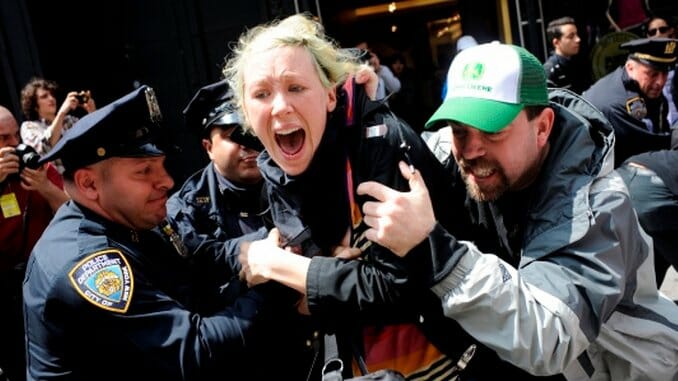99%: The Occupy Wall Street Collaborative Film

99%: The Occupy Wall Street Collaborative Film chronicles political protests that were largely known for not having a clear, cohesive voice. That the documentary also struggles to find a focal point seems so expected it’s almost not worth reporting. Alternating between fascinating and routine, this ambitious movie attempts to track the Occupy Wall Street demonstrations that began in September 2011 in the heart of New York City’s financial district, and tapped into a nation’s—and world’s— anger.
As implied in the laborious title, the documentary is credited to more than 100 filmmakers who contributed footage from the various offspring of the Occupy movement, including both coasts of the United States, the heartland in between and more spots around the world. While its crowd-sourced production might lead you to expect some wild experimentation, the documentary feels fairly conventional. The structure may be tangental and unshapely, but the making of this movie was definitely more authoritative than an Occupy meeting, with “founding directors” Audrey Ewell and Aaron Aites responsible for the final product. Time and money clearly went into both the technical and stylistic aspects of making the different video sources mesh. The principal directors and editors massaged the footage into a disciplined 97 minutes and put it in simple context. Archival news clips set the stage. Talking heads—like Matt Taibbi of Rolling Stone—explain the issues while the movie weaves through different subjects, some fleeting and some recurring.
To establish the anger that fueled the protests, 99% whizzes through topics that either could or do have entire documentaries devoted to them, including wage disparity, the war in Iraq, the mortgage crisis and mega-corporations’ control over politics. It then moves to the zeitgeist’s emergence as its members attempt to establish and manage a fast-growing movement without the defined voice of a single leader or a media-friendly soundbite.
The movie fails to make a convincing argument that Occupy Wall Street affected any major policy changes, but it does provide interesting insight into police brutality, mass communication in the era of social media and the difficulty of managing a huge movement that doesn’t believe in leadership structures. The footage shot in the trenches is the real selling point. It gives a feel for what it was like occupying public spaces. Webcam and cell phone footage calls attention to the new-era grassroots tools that were used to spread the word and make the movement as big as it became.
-

-

-

-

-

-

-

-

-

-

-

-

-

-

-

-

-

-

-

-

-

-

-

-

-

-

-

-

-

-

-

-

-

-

-

-

-

-

-

-








































